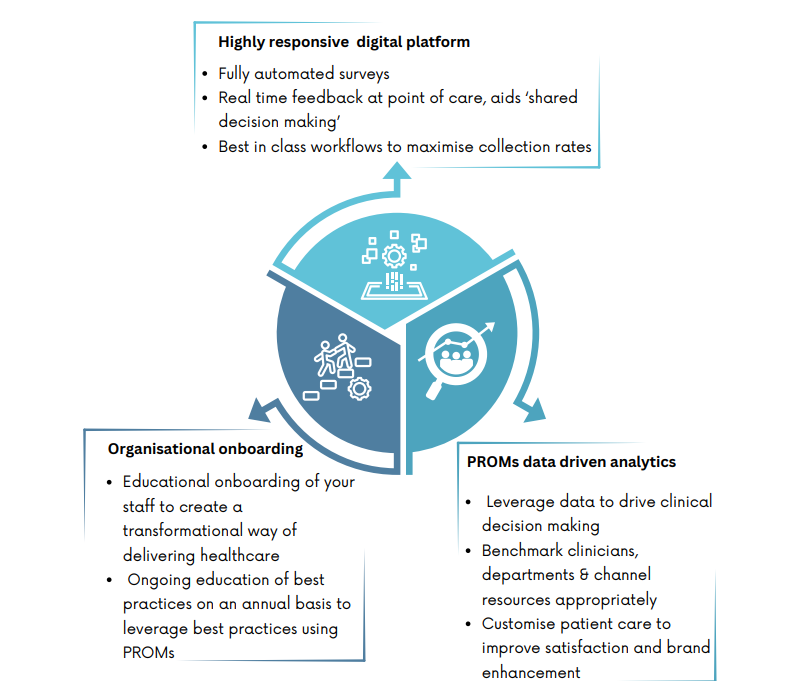Our Services
Patient Reported Outcome Measures
PROMS – AN OVERVIEW
There is an increasing interest in the use of patient reported outcome measures (PROMs) in healthcare delivery. Paucity of resources globally has demanded robust, valid ways of measuring outcomes so that clinical and financial healthcare resources can distributed appropriately.
PROMS are standardised validated questionnaires completed by patients to evaluate how they feel about their health status and outcomes.
When used with real time feedback, PROMs data can be harnessed to tailor individual patient care, obtain feedback on clinician performance and benchmark quality of care within and across healthcare organisations.

THE NEED
With initiatives like value-based health care and pay for performance, PROMS are being viewed increasingly as a policy driven requirement. Healthcare leaders need evidence based models to successfully deploy PROMs in their organisations to fully leverage their potential.

WHY COLLECT PROMS?
PROMs put the voice of the patient first. They are a key component of value based healthcare.

Benefits for patients
An example of real world benefit has been demonstrated by Basch et al. Their study outlined the results of an eight-year programme with 766 cancer patients where a real-time PROM enabled patients to report their symptoms and to send alerts to their nurse carer when symptoms were concerning.

The study's findings are compelling. Basch reports a 10% increase in survival rates for cancer patients from this real-time PROMs approach.
That is a stronger impact than most new cancer drugs achieve!
Checklist for a successful PROMS Program
Follow our proven framework to implement PROMs effectively in your healthcare organization
Transform patient care with digital engagement
Modern PROMs platforms enable seamless data collection and real-time feedback that empowers both patients and healthcare providers.

Lack of clinician engagement
Healthcare professionals need training and support to effectively utilize PROMs data in their clinical decision-making process.

Lack of real time use
Many PROMs programs fail to provide immediate feedback, missing opportunities for timely interventions and care adjustments.

Lack of understanding how PROMs can influence decision making
Organizations struggle to translate PROMs data into actionable insights that improve patient outcomes and operational efficiency.


The design of the program
- Validated and patient centered approach
- Ease of use for patients and frontline clinical worker
- Live data collection and feedback both to patients and clinicians at the point of care

Lack of real time use
- Don’t be over ambitious, define target collection rates realistically
- Patient education for buy-in is key
- Build in digital platforms within patient apps for data collection
- Ensure opt in and opt out processes for patient participation

Staff engagement
- Use technology to allow staff to focus on patient care
- Ensure real time availability of PROMs data within medical records
- Identify champion clinical users to roll out the program
- Provide real time alerts to staff based on PROMs data
Hospital Leadership
- Set SMART goals for each program with regular executive reporting
- Use PROMs data driven decision making at all organizational levels
- Gauge performance and benchmarking capabilities
- Ensure top down and bottom up engagement for success
Summary
Our experience has shown that for PROMs programs to be successfully deployed and embedded in organizations, the following principles are vital:
- Engagement and education of frontline clinical staff prior to deployment
- Strong mandate for organization wide usage from management
- Robust preferably digital based platform to collect and view outcomes
- Testing and refining prior to deployment
- Rigorous feedback loops for evaluation and sharing of learning
What we offer
If you are mandated to use PROMs we strongly recommend you make them part of your organisational culture and DNA. The benefits are immense from a clinical, operational and financial perspective.
Greater patient satisfaction
Increased organizational efficiency
Better clinical outcomes
Improved quality of care provided



